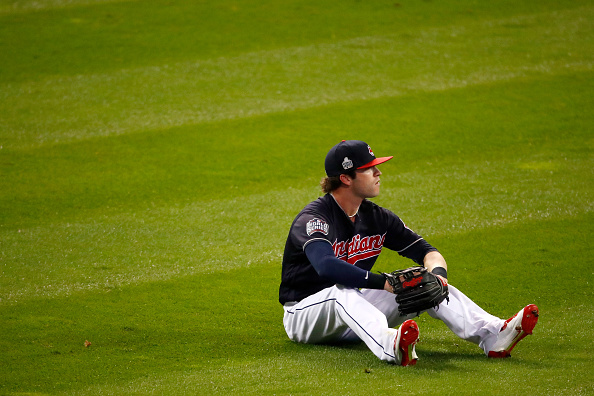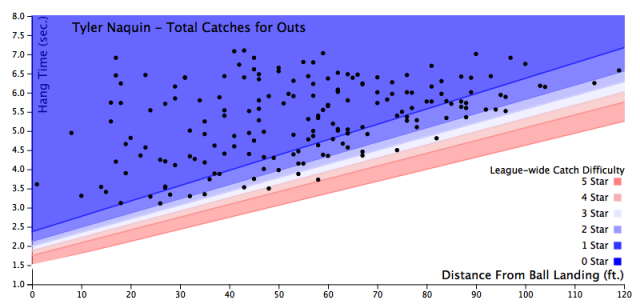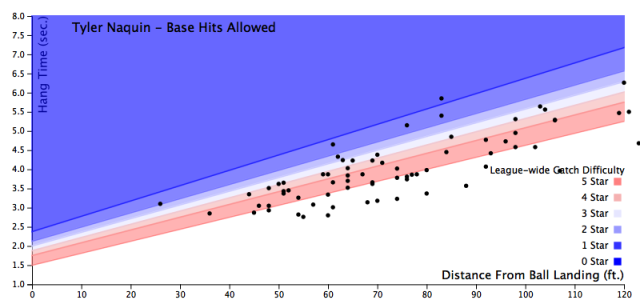Baseball is a very fluid, ever changing sport, even if it’s fans, leadership and analysts aren’t. This can be counter-intuitive with those players not actively participating creating opinions at a first glance that last forever, even if they aren’t warranted. For example, if they knew what he would turn into back in 2010, the Marlins never would have traded Andrew Miller for Dustin Richardson and the Red Sox wouldn’t have traded him for Eduardo Rodriguez in 2014. They shouldn’t have projected him as an elite reliever back then, but he is proof at the most extreme level that a player can change over time.
Tyler Naquin could be a similar, though less extreme, story. He’s been given three chances with the Indians so far, to begin the season in 2016 through May 17th, to begin June to the end of the season and to start the 2017 season. Here is how his numbers break down in each time period.
| Naquin | G | AB | AVG | OBP | SLG | BABIP | K% | BB% | Whiff%High | Whiff%Other |
| Early 2016 | 27 | 63 | .317 | .338 | .413 | .476 | 32.3% | 3.1% | 31.6% | 27.7% |
| Late 2016 | 89 | 258 | .291 | .379 | .539 | .394 | 30.3% | 11.3% | 34.0% | 15.5% |
| Early 2017 | 6 | 17 | .235 | .278 | .294 | .333 | 27.8% | 5.6% | 10.0% | 6.7% |
Since it was hard to describe the last two columns in limited space, the first Whiff% is the percent of fastballs high in the zone that Naquin swung and missed at while the second is the percent he swung and missed at either in the middle or low part of the zone. Only pitches that he swung at within the strike zone are included although he did swing and miss at 20.5% attempts above the zone as well in the late 2016 section.
Any way you look at it, however, his best period was during the regular season from June 1st, 2016 through the end of the year. While his average dropped, this was almost exclusively his BABIP normalizing as he hit for more power, struck out less often and walked much more often. While his swing and miss rate against high fastballs did increase, it dropped significantly on all other pitches.
At the same time, the inability to hit high fastballs was exclusively attacked this way in the post season, leading to a 56% strike out rate and just two base hits and one walk in 26 plate appearances. It was more for this performance that Naquin deserved his early season demotion than anything he did in an extremely limited sample in 2017.
While we didn’t get enough time to see if Naquin had made the changes he needed to early this season (although his extremely low swing and miss rate at all pitches does garner some hope), his numbers in AAA are extremely positive. Before hitting the DL with a sore back on May 2nd, Naquin had a 14 game hitting streak (each of his games in Columbus) including a trio of three hit games. He struck out only eight times, walked five and, including his time in Cleveland, hasn’t committed an error this season (for what that’s worth).
There’s little known about Naquin’s current injury, but he’s eligible to come off the DL today and after a game or two to get back up to speed, it may be time for his fourth shot in the Majors. Surprisingly, one reason could be his defense.
Last year, Naquin was one of the worst center fielders in baseball with a -9.4 UZR/150 almost exclusively based on his range. We’ve seen how he can run, so his lack of range is almost exclusively based on his route selection and first step. The charts below from Baseball Savant show Naquin’s 2016 catches (above) and hits allowed (below) based on the chance they would be caught.
We can see that Naquin caught all, but one easy play, but caught only two beyond the three star mark. In particular, he appeared to have problems on balls with little hang time that landed in front of him. While we don’t have charts for 2017 yet, fangraphs has noted an improvement in Naquin’s range during his week with the team (-0.3 compared to -6.1 in 2016) and considering his extreme youth, there’s great reason to believe he will improve defensively this season.
On the other side, the Indians other center field options have been horrendous. It’s extremely lucky that the Indians have such a strike out heavy pitching staff as Lonnie Chisenhall (-36.4 UZR/150 in CF), Abraham Almonte (-40.1 UZR/150 in RF) and the injured Austin Jackson (-38.7 UZR/150 in CF) have all been terrible defensively. In all three cases, a lack of range is an extreme factor and none have the speed of Naquin to make up the difference.
Unfortunately for Cleveland, while Naquin could be expected to increase overall offense as well as be an equivalent or better center fielder, he provides a similar overall package to Chisenhall and Almonte with an extreme predilection towards right handed pitching (.880 OPS vs RHP, .775 OPS vs LHP). While this would make the Indians devastating against right handers, teams are already rearranging rotations to feature lefties against the Tribe and with or without Michael Brantley, this would give the Indians right handed options of Brandon Guyer and Yandy Diaz.
Because of this, a return of Naquin would necessitate the removal of Almonte. This, however, wouldn’t necessarily be a bad thing given the switch hitter’s recent struggles. While roster consistency is important to maintaining the confidence of a team, the Indians having two options with similar abilities allows them to alternate to whoever the hotter hitter is at the time. Right now (or at least before he was hurt), that hitter is Naquin and as he holds the higher ceiling as well, both offensively and defensively, he certainly deserves another chance.
Add The Sports Daily to your Google News Feed!


